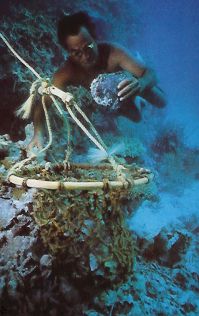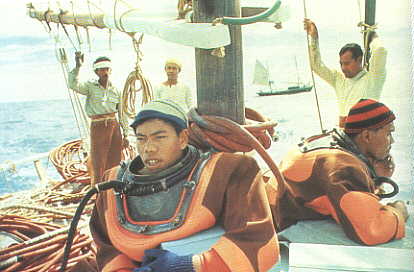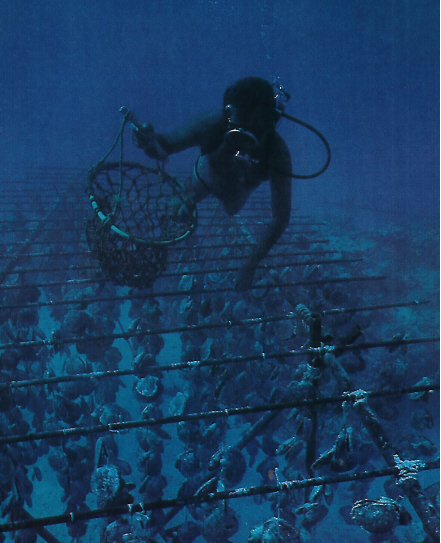Introduction
Many thousands of years ago, long before written history, human beings probably
discovered the first pearl while searching the seashore for food. Throughout
history, the pearl, with its warm inner glow and shimmering iridescence, has
been one of the most highly prized and sought-after gems. Countless references
to the pearl can be found in the religions and mythology of cultures from the
earliest times. The ancient Egyptians prized pearls so much they were buried
with them. Cleopatra reportedly dissolved a single pearl in a glass of wine and
drank it, simply to win a wager with Mark Antony that she could consume the
wealth of an entire nation in just one meal.
In ancient Rome, pearls were considered the ultimate symbol of wealth and social
standing. The Greeks held the pearl in high esteem for both its unrivaled beauty
and its association with love and marriage. During the Dark Ages, while fair
maidens of nobility cherished delicate pearl necklaces, gallant knights often
wore pearls into battle. They believed the magic of these lustrous gems would
protect them from harm. The Renaissance saw the royal courts of Europe awash in
pearls. Because pearls were so highly regarded, a number of European countries
actually passed laws forbidding anyone but the nobility to wear them.
Australian
Pearling
|
In the 1870s, divers off the coast of
Australia discovered something great. It was the Pinctada maxima oyster.
The large size of the oysters
attracted the attention of local traders. In the beginning, the oysters were
pickup up by Aboriginal nacked divers. Most of these divers were women. They had
a larger lung capacity then the male divers and could pick up more shells in one
dive. Soon after that pearling schooners filled with
Sri Lankan divers began to harvest the oysters. Still for its shell rather than for
the pearls they contained.
The early luggers were sail-powered and only catered for one diver's
apparatus, but by the 1930s, most vessels were motorised and mechanical air
pumps allowed two divers per boat.
The Pinctada maxima
oysters grow in the waters of Australia,
Papua New Guinea, Indonesia, the Philippines, Thailand, and Myanmar (Burma). The saltwater pearls
they can contain come in both silver-
and gold-lipped form. The colors can range from white to gold. Overtones of the
silver-lipped oyster has overtones of silvery white or bluish white. The
gold-lipped variety has overtones of gold, cream or silver. The size of South
Sea pearls range from 10 to 20 millimeters, but pearls larger than 16
millimeters are rare.
In the beginning, the oysters were so plentiful that at low
tide they could be picked from the exposed sand. As the oysters became depleted,
more and more sophisticated diving methods had to be used. Before the invention of synthetics like plastic, Mother of Pearl shell was
used across the world to make buttons, in jewelery and for decoration. A
pearling settlement was founded at Roebourne Bay in 1880. In 1883 it was named
Broome, after the then Governor of Western Australia.
|

|
By 1901 the pearling trade employed 2000 people from many nations. The
majority were Japanese and Malaysian, but Chinese, Filipino, Amborese, Koepanger
(Timorese) and Makassan workers, as well as Aboriginal Australians and people
from a range of European nations worked in the pearl trade.
As the Australian pearl industry boomed,
the small town of Broome became the pearling center. In fact, South Sea pearls
were originally called "Broome pearls". Within three years of the
original discovery, Australia was supplying 75 percent of the world's supply of
mother-of-pearl for making shirt buttons.
In the early years of the twentieth century the pearl shell trade boomed. By
1912 there were more than 400 pearl luggers working from the port of Broome,
spending months at sea gathering the precious shell and pearls. It is said that before the
First World War Broome was the source of three quarters of the world's pearl
shell.
Like many other parts of Australia, Broome was greatly effected by the First
World War. The international trade in the shell stopped for 2 years. Shell could
not be sold and sat in storage in Broome. Pearling crews could not work and the
whole town suffered.
While the 1920s saw a recovery in the industry, the 1930s-1950s were
difficult for Broome's pearl trade. The great depression made it hard to get
good prices for pearl shell. The natural pearls found from harvested
oysters were a rare bonus for the divers. Many fabulous specimens were found
over the years. By the 1930s, over harvesting had
severely depleted the oyster beds. The government was forced to strictly
regulate the harvest to prevent the oysters from becoming extinct.
|

Divers in TOA gear
|
By 1939 only 73 luggers and 565 people were left in the industry and during
the Second World War, pearling virtually stopped. Japanese divers discreetly
went home or were interned. Broome was bombed, destroying many of the
remaining luggers.
After the war, anyone who had known Broome in its roaring days would hardly
have known the place, and a mere 15 boats on average worked the fishery,
employing around 200 people.
The divers were mostly Japanese
from the Taiji province. Their diving ritual would often begin by downing a
bottle of port, before donning their diving helmets, after which they would be
lowered over the lugger's side to spend hours underwater.
On the bottom they struggled
about in their heavy gear, often almost horizontal, frantically scooping oysters
into bags because divers were paid by the amount of shell they collected. Pity the diver on the bottom when his lugger was smashed by one of the four
cyclones to catch the pearling fleet at sea between 1908 and 1935. The death
toll for these is only approximate but it is known that more than 100 boats and
nearly 300 Japanese perished, and are commemorated at the Japanese cemetery in
Broome. |
In total, more than 800 divers and their support crews lost their lives because of
cyclones between 1882 and 1935. In only 3 years, 1912 to 1915, 93 divers died
from the bends. These were boom years for the industry, but the price in human
terms was very high.
Commercial pearl
culturing
The first commercial pearl culturing farm
began in Western Australia in 1956. People in Broome began to look
at growing pearls, rather than harvesting their shells. In 1956, the Kuri Bay
cultured Pearl farm produced their first World Superior pearl. Today, Australia produces about 60 percent of
the world's South Sea cultured pearls.
Pearl farming continues to be Broome's major industry. In 1992 there were 12
cultured pearl farms operating around Broome.
Little of early days remains - a couple of luggers, a few historic buildings
on new sites, rotting jetties, the Japanese cemetery of gracefully calligraphed
stones, the modest but absorbing museum and a few helmets, now valuable
artefacts and integral parts of pearl shop displays.
Seeding involves cutting a small section of mantle from a donor oyster and
placing it next to bead which is implanted in the oyster, this grafting process
forms a sac round the bead and excretes nacre, thus forming a pearl. The seeded
oyster is then returned to the sea to recover before being taken to the pearl
farm.
Normal growing time is two years but the cages are removed at regular
intervals, the shells cleaned and rotated, to assure the best possible results
in forming a cultured pearl.
Most farms now use X-ray machines to check if the bead has been rejected, if
so the oyster can be reseeded.
Good healthy oysters can be seeded up to three times, producing a pearl every
two years. Oysters that are still healthy are then used to produce
"Mabe" or half pearls. This is done by cementing half beads of varying
shapes onto the shell inside the oyster, up to seven can be placed in one
oyster.
These are harvested by drilling the pearl shell with the pearl and processing
the half pearl. These are made round, oval, drop or heart shape.
Suggested reading
- Taylor, M.(1985) The pearling industry of Western Australia 1850 -1985.
- Bartlett, N. (1954) The pearl
seekers
- Idriess, I. (1937) Forty
fathoms deep
- this page was last edited on
February 28th 2005


